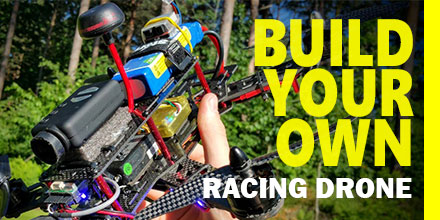15Mar
Racing Drones: How to Build One in a Few Easy Steps
 After revolutionizing the photography and film-making industries, it was inevitable that the racing industry would also feel the impact of drones.
The most popular form of competitive drone racing is First Person View (FPV). Such events are quickly gaining traction among UAV enthusiasts and the mainstream media.
With the backing of some wealthy benefactors, drone racing’s popularity is only set to rise.
If you would like to head off to the races, read on to learn how to build a racing drone in a few easy steps.
After revolutionizing the photography and film-making industries, it was inevitable that the racing industry would also feel the impact of drones.
The most popular form of competitive drone racing is First Person View (FPV). Such events are quickly gaining traction among UAV enthusiasts and the mainstream media.
With the backing of some wealthy benefactors, drone racing’s popularity is only set to rise.
If you would like to head off to the races, read on to learn how to build a racing drone in a few easy steps.
Racing Drones Explained
Most racing drones tend to be quadcopters built with speed and agility in mind. In the case of FPV racing, the drones also have a camera and video transmission system that allows the pilot to see a first-person view of the UAVs flight path through a set of goggles. Racing drones are an exciting way to gain flight experience and fine-tune your maneuvering skills. For beginners, buying an assembled racing drone may be the best option. However, if you’re looking for a truly competitive edge then a self-built model is the way to go. Most professional pilots prefer to build their own machines because it allows them to completely customize their vehicle. Drone technology is still relatively new but innovations happen quickly. A self-built drone allows you to create the fastest drone possible at any given time.Preparing for your Racing Drone Build
To get started, you’ll need to gather all the requisite parts, tools, and equipment. First step, consider the type of frame you would like to use. As mentioned above, a quadcopter frame is most favored by racers for its stability and versatility. A quadcopter has four arms, each fitted with a motor for flight. Popular frames include the Alien 5’’ FPV Frame, the Raceblade FPV Racing Quadcopter, and the MCQ One quad frame. Frames, on average, cost around $100. Once you choose your frame, you will also need to select: motors, propellers, antennas, a radio transmitter and a receiver, an on-board camera, batteries, and FPV goggles. As a general rule, your motor should achieve a 2:1 thrust to weight ratio. However, you should try and achieve a much higher ratio than this. Figures of 8:1 or 10:1 ratios are not uncommon in the world of drone racing.Other Equipment Considerations
- Cameras: Popular FPV cameras include brands such as FatShark, but a great starter package is the Eachine CMOS camera and transmitter kit at under $50.
- Transmitters: Leading transmitter brands include Boscam and Crazepony which get you up and running for under $30.
- Props: The best FPV props are those from Gemfan and market leader HQProp and will cost a mere $3 for two pairs.
- Batteries: Larger batteries mean longer flight times but the extra weight could slow down your drone so always choose the best power source you can find. Top brands include TATTU and GensAce.
- Goggles: If you are a new pilot, it is advisable to start off using your monitor as this allows you to quickly glance up to see the UAV during flight. Once you gain experience the best FPV goggles include the Aris Skyzone, FatShark Dominator, and models from HeadPlay.

 Drones are proving indispensable for a wide variety of applications. From aerial photography and film-making to agriculture and search and rescue operations, drones are now firmly part of the mainstream.
But there's another area where drones are starting to make a huge impact...the racing arena.
Once simply a pastime for RC enthusiasts, drone racing is quickly emerging as a sport widely regarded as the "next big thing".
And, why not? Drone racing features all the elements associated with big time racing: exotic locations, skilled pilots, high speeds, iconic courses, and, of course, wrecks. Plus, it now features all the other elements of organized leagues: television contracts, financial backers, big name sponsors, monetary prizes, and recognized racers.
Drone racing has arrived.
Drones are proving indispensable for a wide variety of applications. From aerial photography and film-making to agriculture and search and rescue operations, drones are now firmly part of the mainstream.
But there's another area where drones are starting to make a huge impact...the racing arena.
Once simply a pastime for RC enthusiasts, drone racing is quickly emerging as a sport widely regarded as the "next big thing".
And, why not? Drone racing features all the elements associated with big time racing: exotic locations, skilled pilots, high speeds, iconic courses, and, of course, wrecks. Plus, it now features all the other elements of organized leagues: television contracts, financial backers, big name sponsors, monetary prizes, and recognized racers.
Drone racing has arrived.
